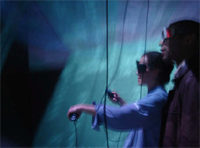UNFOLDING SPACE
Thesis Project Documentation
April 14th, 2006
Categories: Applications, MFA Thesis, Visualization, VR, VR Art

Authors
Aguilera, J.About
UNFOLDING SPACE is a VR enveloping landscape of concave and convex forms, which are determined by the orientation and displacement of the user in relation to a grid made of tesseracts (cubes in four dimensions). The interface accepts input from tridimensional and four dimensional transformations, and smoothly displays such interactions in real-time. Instead of navigating the familiar landscape of volumes, space is attached to the shadow of a higher dimensional grid, which can then be turned around, to stretch or compress their sides to face the person. Such shadow projected to three dimensions use the distortion of tridimensional perspective to organize visual hierarchy. Stereo visualization and real-time computer graphics also allow us to integrate the dynamic abilities of the human body for accessing higher dimensions while assimilating complex configurations. The motion of the person becomes the graphic element whereas the higher dimensional grid references to his / her position relative to it. The person learns how motion inputs affect the grid, recognizing a correlation between the input and the transformations.
Tridimensional projections can be flattened to the screen of a computer, and so can higher dimensions. Higher dimensions may cause concern because we are only used to three dimensions when we move around the world with our bodies. But if we were two dimensional beings, and were to be shown a tridimensional object, all we could see from it would be its two dimensional shadow crossing our plane of existence over time. Since we are not two dimensional beings, but tridimensional ones, UNFOLDING SPACE confronts us with a structure which is one dimension higher than our perceptual world. The design tool to make such space visible is the grid8: the same way that a flat space can be shown through a grid of squares and tridimensional space can be revealed through a grid of cubes, four dimensional space, can be revealed through a grid of tesseracts (the four dimensional projection of a cube), in this case, casted into three dimensions. What we end up seeing is a flexible space that expands and collapses, self-intersecting depending on our position in relation to it. Of course the fourth dimension can cast a shadow in either two dimensional or tridimensional space, but I base its parameters on a tridimensional shadow since that is closer to the natural experience of moving our bodies through space.
Resources
URL
Citation
Aguilera, J., UNFOLDING SPACE<br>Thesis Project Documentation, EVL, MFA Thesis, April 14th, 2006. http://www.evl.uic.edu/julieta/thesis/docs/UNFOLD_thesis.pdf